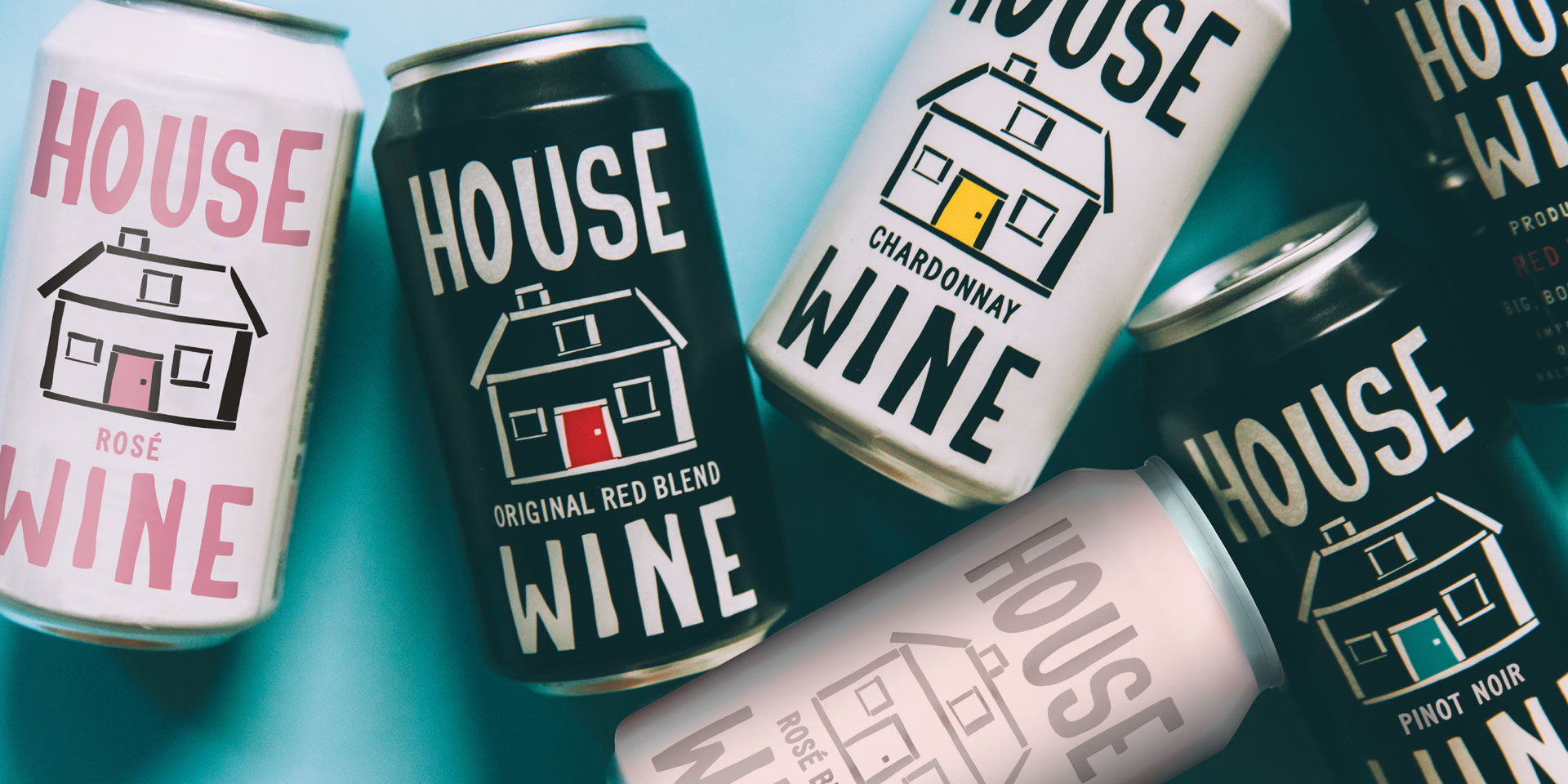Canned Wine Sales Are Steadily Growing — Not
Just with the Twenty/Thirty-Something Crowd
There’s one thing most canned wine producers seem to agree on: The best seller in many of their portfolios is almost always rosé.
By Ken Robertson
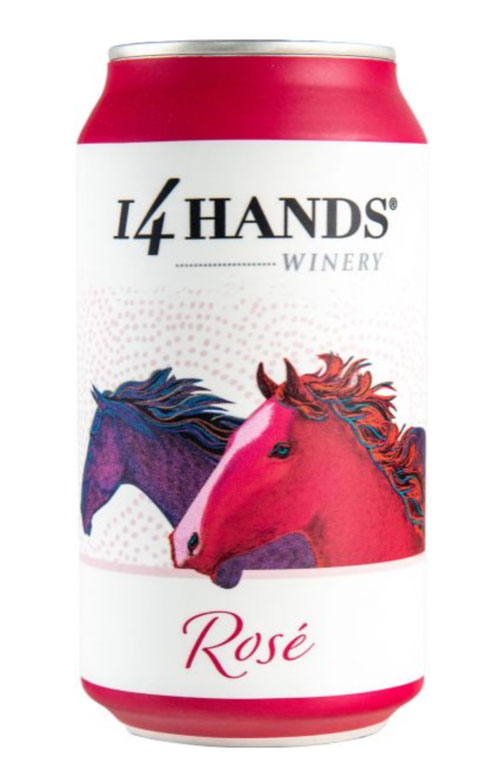
14 Hands Winery, a subsidiary of Ste. Michelle Wine Estates located in Prosser, WA., has embraced the canned wine movement in a big way, selling thousands of reds, whites, rosés and sparkling wines in six-pack aluminum containers annually.
If rosé is the official wine of summer, for those who have ever been twenty-somethings, the unofficial wine of summer might be canned rosé — likely a sparkling version.
After all, Brad Mayer, whose job is to promote the canned wine portfolio of Seattle-based Precept Wine, the Northwest’s largest privately owned wine company, is proud to boast that its nationally distributed House Wine is the country’s No. 1-selling 375-milliliter wine in cans.
And there’s one thing most canned wine producers seem to agree on: The best seller in many of their portfolios of canned wines is almost always rosé, often their sparkling rosé.
Canned wines are usually built just a little differently than their glass-bottle running mates, partly because of the audience they aim to please — the twenty-something and the thirty-something crowd and outdoors-minded consumers who love backpacking, hiking, boating, picnicking and an array of other activities.
For boating or hanging around a swimming pool, the traditional glass bottle can be a liability, several winery officials said in interviews, which they believe makes their canned wines an appealing solution.
But Mayer sees the bigger picture: “Canned wines have caught on quickly with a wide range of consumers. While they may have appealed to younger consumers or outdoors enthusiasts at first, they are now much more mainstream. We are seeing great success with canned wine, not just in off premise retail but also in on premise venues as well.”
Producers large and small offer not only canned wines but also lighter, low-alcohol beverages that may combine the flavors of wine and fresh fruit, plus whatever else their research shows consumers may want, with a choice of sizes, usually 375- or 250-milliliter aluminum containers, some of which look more like a bottle than a can. A 375-milliliter can contains 13-plus ounces, half as much as a traditional glass 750-milliliter bottle.
The Northwest’s largest winery group, Chateau Ste. Michelle Wine Estates, offers its wines and other beverages under multiple labels, including Ste. Michelle and 14 Hands, with reds, whites, rosés and sparkling wines all available in aluminum containers.
One of their former winemakers, Reid Klei, spent part of his 15 years there working on the canned wine project for 14 Hands, where he said they spent a lot of time and effort determining the best possible packaging. As a winemaker, Klei’s focus was on ensuring the quality that went into the can was preserved until the wine was poured. Among the keys was finding the right can liner. “It turned out the blue liner was the best,” he noted.
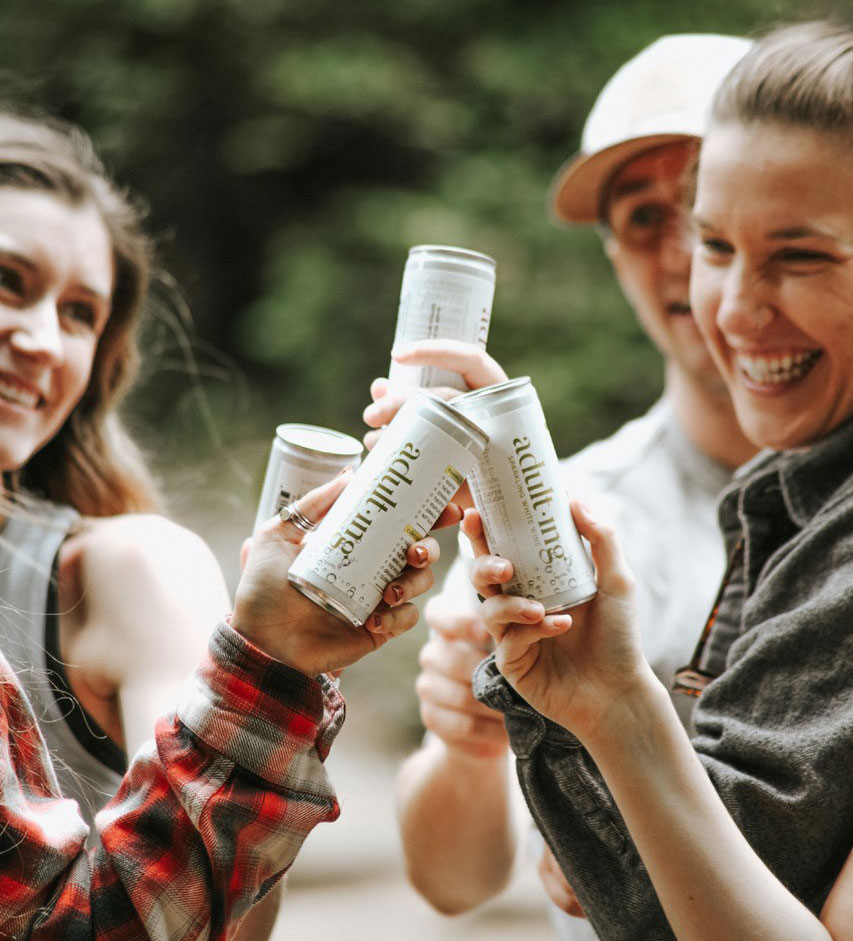
Alexandria Nicole Cellars of Prosser, WA., sells the canned wines it produces under the winery’s “Adulting” brand. The winery makes three versions of its canned wines — a rosé, a white and a red. All are blends, and the rosé and the white are canned with a bit of CO2 to add spritz.
Now the winemaker for Alexandria Nicole Cellars in Prosser, WA., Klei currently oversees production of about 30,000 cases of wine, with about 2,000 cases of the total going into cans under the winery’s “Adulting” brand. The cans are sold through the winery’s tasting rooms at its Destiny Ridge Winery in the Horse Heaven Hills, in Prosser and Seattle, plus two in the Woodinville area.
Winery owner Jarrod Boyle said he’s found many of the 4,000-plus members of Alexandria Nicole’s wine club are fans of the canned versions of his wines, which include a rosé, a white and a red. All are blends, and the rosé and the white are canned with a bit of CO2 to add spritz, which Boyle and Klei both said enhances their aromatics.
Rosé is the most popular, but “once they try the white, they love it,” Boyle said. “It’s been going so well with our wine club, we’re just selling it in our tasting rooms.”
Every step of the process for producing the Adulting wines has been carefully reviewed and tweaked as necessary, they said. For example, they experimented with adding spritz to the red blend, but decided it might be a bridge too far for many consumers to cross.
“Our canned wine is not an afterthought,” Boyle added. “We want it to be worth it.”
The red blend is 81% Syrah, 13% Mourvèdre and 6% Grenache, so it’s distinctly Rhône styled. The white is 29% Muscat, 27% Riesling, 15% Albariño, 12% Roussanne, 11% Viognier and 6% Sauvignon Blanc, a combination that makes it highly aromatic. The rosé combines 40% Merlot, 22% Cabernet Sauvignon,21% Syrah, 8% Cabernet Franc, 7% Riesling and 2% Muscat.
At Alexandria Nicole, canned sales are not driven solely by demographics, he said. Weddings, special events and “when it’s sunny out” appear to be major factors. The popularity has him considering whether it might make sense to add canned single varietals and maybe even canned cocktails.
He has no desire to compete directly “with the big guys” such as Ste. Michelle and Precept. “We put lots of focus on our wine club.”
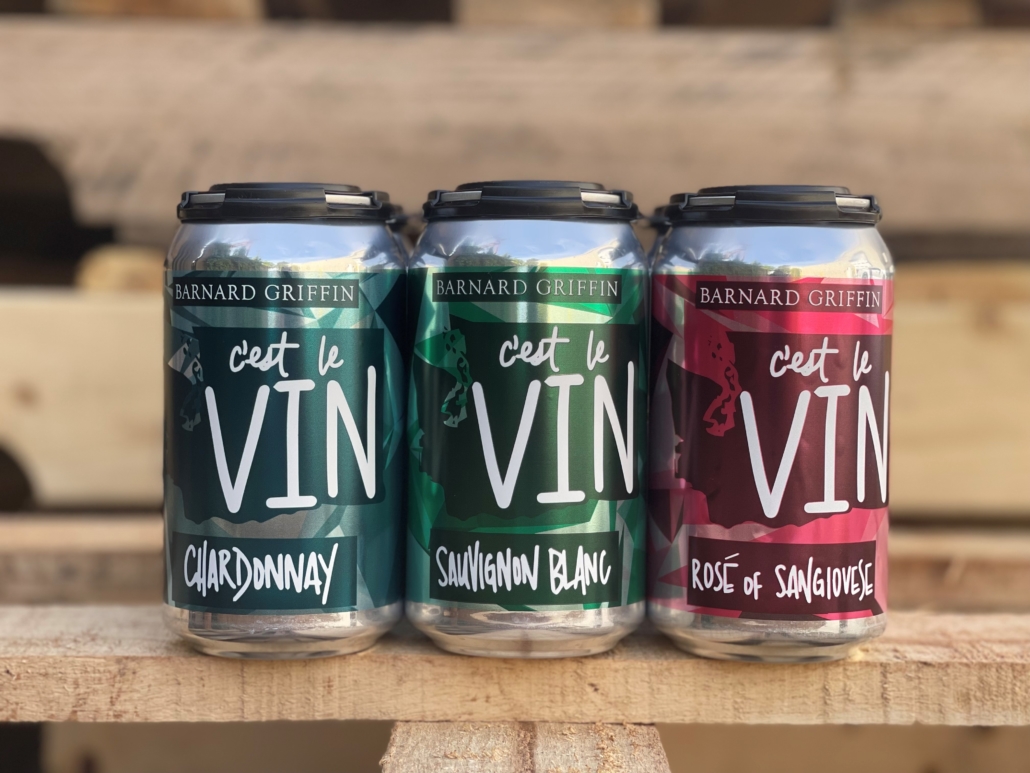
Barnard Griffin Winery, which is located in Richland, WA., launched its canned wine program “before it was a thing.” The winery produces three varieties of canned wines, which it sells under its “Cest Le Vin” label — a Sauvignon Blanc, a Rosé of Sangiovese and a Chardonnay. Their Rosé of Sangiovese is nationally known and a perennial gold medal and sweepstakes winner at the San Francisco Chronicle wine judging competition.
At Barnard Griffin Winery, located in Richland, WA., the aim is similarly modest.
Megan Hughes, who oversees the canned wine program for her family-owned operation, aims to sell about 3,000 to 4,000 cases of canned wines annually, eventually reaching about 10% of the winery’s total sales, depending on the market. “We could get up to 8,000 cases,” she added.
Barnard Griffin launched its program a few years ago, just “before it was a thing.” Now, cans are a well-accepted part of the beverage market.
They produce three varieties, Sauvignon Blanc, Rosé of Sangiovese and Chardonnay.
“It’s the same juice that we put in glass bottles,” Hughes said.
One surprise is that although Barnard Griffin’s Rosé of Sangiovese is nationally known and a perennial gold medal and sweepstakes winner at the San Francisco Chronicle wine judging — the nation’s largest — the rosé is not quite their most popular canned wine.
The Sauvignon Blanc sells just slightly better, perhaps an indication that her dad Rob Griffin’s longtime devotion to that varietal is paying off with Barnard Griffin’s consumer base. Hughes also notes, “There are so many other rosés around.”
In addition to the usual consumer base for canned wines — boaters, hikers, backpackers, etc. — Hughes said many customers are “people who are concerned about environmental consequences and like the renewable aspect of aluminum.”
One of the largest canned wine ventures among Washington’s smaller winemakers is also among the state’s largest wine grape growers. The Monson family raises about 2,200 acres of grapes in the new Goose Ridge AVA just west of the Tri-Cities.
A diversified operation that also grows apples and cherries and raises 200 acres of cattle, the Monson family sells most of its wine grapes, reserving a small share for their winery, Goose Ridge Estate Vineyard and Winery, and their canned wine operation, Cascadian Outfitters.
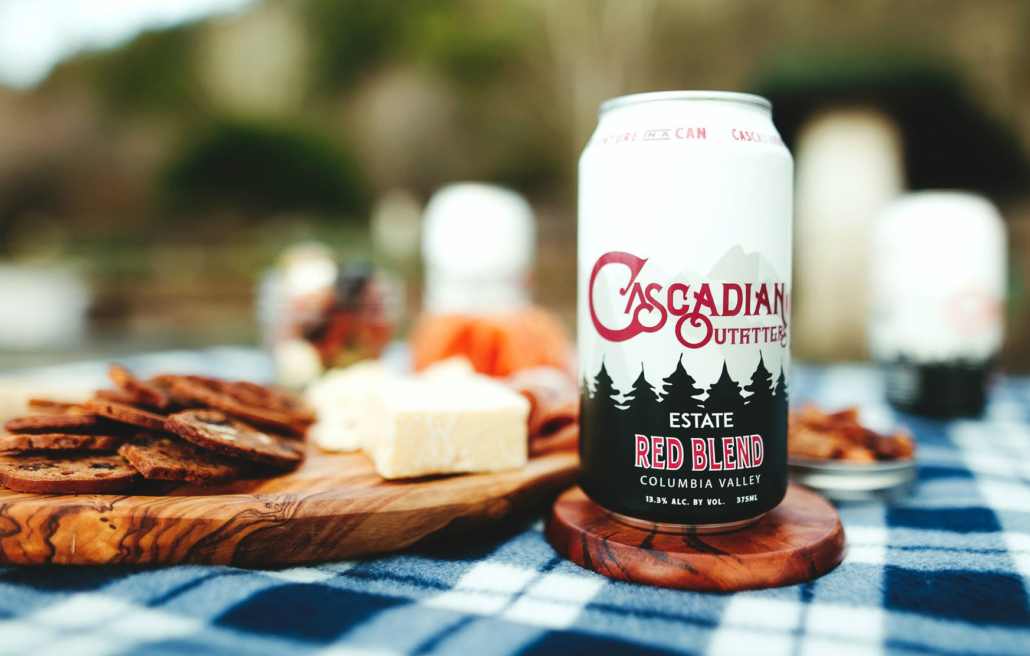
A picnic on a beautiful summer day is what Taylor Monson, director of sales and marketing for Cascadian Outfitters, had in mind when her company started making wine in cans in 2018. A subsidiary of Goose Ridge Estate Vineyard and Winery in Richland, WA., Cascadian Outfitters produces five versions of canned wines — a Chardonnay, a rosé, a red blend, a sparkling rosé and a sparkling white.
The Cascadian brand, which Taylor Monson, the director of sales and marketing, notes is made from 100% estate grapes, was launched in 2018 and has grown to 6.000 to 8,000 cases produced annually. The canned wine varieties they produce include a Chardonnay, a rosé, a red blend, a sparkling rosé and a sparkling white.
You can find Cascadian in about a dozen states, she said, including Washington, Oregon, Idaho, Colorado and Montana. Possible additions to their portfolio include a distilled vodka and gin made from wine grapes.
Promotional activities and donations to charitable fund-raisers have made the brand popular on the west side of Washington state, and Pride Month, combined with June’s warming weather, especially seems to spark sales.
Canned wine sales for Cascadian continue to grow significantly, even though it’s “now getting normalized,” Monson explained.
“We’re having fun with it,” she said. “Our canned wines regularly get great reviews,” she added, noting Good Housekeeping magazine recently named their rosé “one of the top 15 wines to drink this summer.”
No matter how you spend your summer, Washington’s canned wines, widely available in outlets ranging from tony wine shops to gas station convenience stores, offer something to please most every palate. Prices usually range from $5 to $7 for a 375-milliliter can.
EDITOR’S NOTE: Ken Robertson has been sipping and writing about Northwest wine since 1978. His articles have appeared in several magazines and on several websites.

